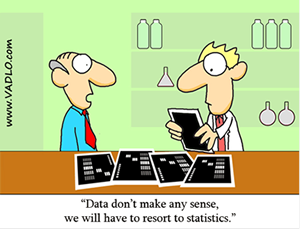Online Course
NRSG 795: BIOSTATISTICS FOR EVIDENCE-BASED PRACTICE
Module 1: Variables, Values, and Spreadsheets as Databases
Overview
The accessibility and the ability to do the basic statistical analyses required for this class should promote your ability to analyze data in future classes as well as in your personal and work life. While the mechanics (e.g., which button to push) of how to perform the different statistical procedures differs by which software package one uses, the fundamentals of why a particular test is chosen and what it is doing is constant regardless of the software.
This introductory module reviews basic concepts and terminology that are foundational in statistics and data analysis. You will learn to understand datafiles by using information found in a codebook to understand the variables, labels and values. You will also learn to differentiate the levels of measurement and understand why this idea is important in statistics. Some issues related to missing data are covered briefly because it is important to understand how the quality of the evidence can be seriously compromised when there are values missing for some study participants in your datasets. Finally, this module ends with advice on how to write numbers for the purpose of EBP or research purposes.
This introductory module also introduces you to the software that will be used to do statistical analyses in this class. Here you have options, 1) either learn how to do the exercises using EXCEL (in brief pro-free and con- maybe steep learning curve) or 2) use the link that is provided to purchase access to IntellectusStatistics. Intellectus Statistics should eliminate some of the frustration of learning how to perform analyses in excel so that you can focus more on learning why we perform the statistics and the meaning/interpretation of what you find.
I highly suggest you select ONE method (EXCEL or Intellectus Statistics) and continue with it throughout the course. It will not be wise to try going back and forth. There is no need to learn both programs as the results each program provides will lead to the same conclusions. Throughout this course instructions for either statistical method will be clearly marked. Excel users are encouraged to view the Excel corner tab found in many of the modules for additional tips and instructions of how to do things in Excel. Regardless of which you select to use to perform analyses, everyone will be using Excel to gain access to the datafiles.

Objectives
At the conclusion of this module, the learner will be able to:
- Create an electronic database in spreadsheet or statistical software.
- Understand a datafile codebook
- Distinguish among the levels of measures of variables.
- Understand various types of missing data and number formatting
Directions
Select which program you will use. Make sure you have access to the program you want and that it is working. Start to get familiar with the software. Read the applicable module sections pertinent to the approach you have chosen to use.
Required readings and videos are assigned within the subtopics. Videos have often been selected to supplement the text and to help those using Excel. Some of the selected videos were produced for a class at another university. While this may seem distracting at times, the videos were carefully selected to find the most appropriate for this class.
Learning activities within the subtopics are designed to help you apply what you learned. These activities will often include data that you must manipulate to answer specific questions. These will prepare you for the analytical assignments that make up part of your grade.
This website is maintained by the University of Maryland School of Nursing (UMSON) Office of Learning Technologies. The UMSON logo and all other contents of this website are the sole property of UMSON and may not be used for any purpose without prior written consent. Links to other websites do not constitute or imply an endorsement of those sites, their content, or their products and services. Please send comments, corrections, and link improvements to nrsonline@umaryland.edu.